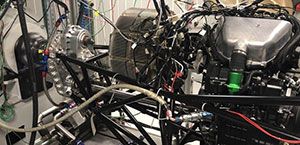
VoltAero Initiates Certification Testing for Electric-Hybrid Powertrain to Equip Cassio 330 Aircraft

In a major new milestone for VoltAero’s development of its Cassio e-aircraft family, the company’s parallel electric-hybrid powertrain has begun certification testing for the five-seat Cassio 330 version. The ground-based test bench runs of Cassio 330’s powertrain are underway at the Bayonne, France, facility of AKIRA Technologies.
Installed on a ground-based test bench, this powertrain integrates the key elements for series production Cassio 330s: Safran Electrical & Power’s ENGINeUS™ 100 smart electric motor and Kawasaki’s four-cylinder high-performance thermal engine derived from the iconic Ninja® motorcycle. The powertrain has a combined electric-hybrid power of 330 kilowatts, with 180 kilowatts delivered by the ENGINeUS™ 100 electric motor and 150 kilowatts provided by the Kawasaki thermal engine.
“Full-scale powertrain certification testing for our Cassio 330 marks another important step in VoltAero’s commitment to produce a new-generation electric-hybrid aircraft family, bringing together our proprietary powertrain with an airframe that is optimized for aerodynamic and operational efficiency,” says Jean Botti, VoltAero’s CEO and chief technology officer.
Botti adds that VoltAero’s overall architecture for the Cassio 330 powertrain already has been validated during extensive flight testing with the company’s Cassio S testbed airplane, which is equipped with a powertrain version rated at 600 kilowatts — the most powerful electric-hybrid system of its type that is flying today. Cassio S has performed more than 230 flights since October 2020, surpassing the combined 170-flight-hour mark while covering 15,000 kilometers and visiting 40-plus airports.
The VoltAero parallel electric-hybrid propulsion concept for Cassio is unique, with the aircraft using the electric motor in its aft fuselage-mounted propulsion unit for all-electric power during taxi, takeoff, primary flight (if the distance traveled is less than 150 kilometers), and landing. The hybrid feature — with the internal combustion engine integrated in the powertrain — comes into play as a range extender, recharging the batteries while in flight and serving as a backup in the event of a problem with the electric propulsion, ensuring true fail-safe functionality.
By integrating VoltAero’s parallel electric-hybrid propulsion system into the company’s purpose-designed airframe, Cassio will deliver a higher performance, as compared to the current competition, and provide significantly lower operational costs. The Cassio airframe design is based on a sleek fuselage; a forward, fixed canard; and an aft-set wing with twin booms that support a high-set horizontal tail.
VoltAero’s first production aircraft version will be the Cassio 330, for which the company has targeted certification in late 2025. It will be followed by the six-seat Cassio 480, with a combined electric-hybrid propulsion power of 480 kilowatts, and the Cassio 600, sized at a 10/12-seat capacity with electric-hybrid propulsion power of 600 kilowatts.
The Cassio aircraft family will be a highly capable and reliable product line for applications that include regional commercial operators, air taxi/charter companies, private owners, as well as utility-category service for cargo, postal delivery and medical evacuation (Medevac) applications.
VoltAero’s headquarters and technical offices currently are located at Médis, France. A new purpose-built facility incorporating the final assembly line for Cassio aircraft is under construction at Rochefort, France, and is to be inaugurated later this year.
For more information, visit www.voltaero.aero.
